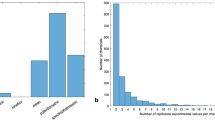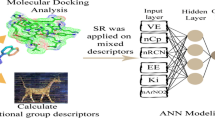Abstract
During the last years artificial neural networks (ANN) have been applied successfully in the QSAR field. It has been demonstrated that this new technique is often superior to the traditional Hansch approach, providing more accurate predictions. The advantage of ANN is that with the presence of hidden layers, neural networks are able to perform nonlinear mapping of the physicochemical parameters and of the corresponding biological activity.
Access this chapter
Tax calculation will be finalised at checkout
Purchases are for personal use only
Similar content being viewed by others
References
López-Rodriguez et al.,2-[4-(o-Methoxyphenyl)piperazin-l-ylmethyl]-1,3-dioxoperhydroimidazo[1,5a]pyridine as a new selective 5-HT,A receptor ligand, Bioorg. Med. Chem. Lett. 6:689 (1996).
LópezRodriguez et al.,Synthesis and structure-activity relationships of a new model of arylpiperazines. 1. 2-[[4-(oMethoxyphenyl)piperazin-l-yl]methyl]-1,3-dioxoperhydroimidazo[1,5-α]pyridine: a selective 5-HT, receptor agonist, J. Med. Chem. 39:4439 (1996).
López-Rodriguez et al.,Synthesis and structure-activity relationships of a new model of arylpiperazines. 3. 24,3-(ω-Arylpiperazin-l-yl)alkyllperhydropyrrolo[1,2c]imidazoles and -perhydroimidazo[1,5-a]pyridines: study of the influence of the terminal amide fragment on 5–11T,A affinity/selectivity, J. Med. Chem. 40:2653 (1997).
López-Rodriguez et al.,1-[ω-(4Arylpiperazin-1 yl)alkyl]-3-dipheny]methylene-2,5-pyrrolidinediones as 5-HT, receptor ligands: study of the steric requirements of the terminal amide fragment on 5-HT, affinity/selectivity, Bioorg. Med. Chem. Lett. 8:581 (1998).
López-Rodriguez et al.,Synthesis and structure-activity relationships of a new model of arylpiperazines. 2. Three-dimensional quantitative structure-activity relationships of hydantoin-phenylpiperazine derivatives with affinity for 5-HT, and a, receptors. A comparison of CoMFA models, J Med. Chem. 40:1648 (1997).
Author information
Authors and Affiliations
Editor information
Editors and Affiliations
Rights and permissions
Copyright information
© 2000 Springer Science+Business Media New York
About this chapter
Cite this chapter
López-Rodríguez, M.L., Rosado, M.L., Morcillo, M.J., Fernández, E., Schaper, KJ. (2000). Application of Artificial Neural Networks in QSAR of a New Model of Phenylpiperazine Derivatives1 with Affinity for 5-HT1A and αl Receptors: A Comparision of ANN Models. In: Gundertofte, K., Jørgensen, F.S. (eds) Molecular Modeling and Prediction of Bioactivity. Springer, Boston, MA. https://doi.org/10.1007/978-1-4615-4141-7_113
Download citation
DOI: https://doi.org/10.1007/978-1-4615-4141-7_113
Publisher Name: Springer, Boston, MA
Print ISBN: 978-1-4613-6857-1
Online ISBN: 978-1-4615-4141-7
eBook Packages: Springer Book Archive




